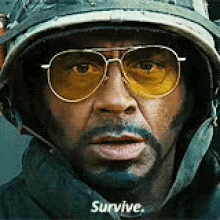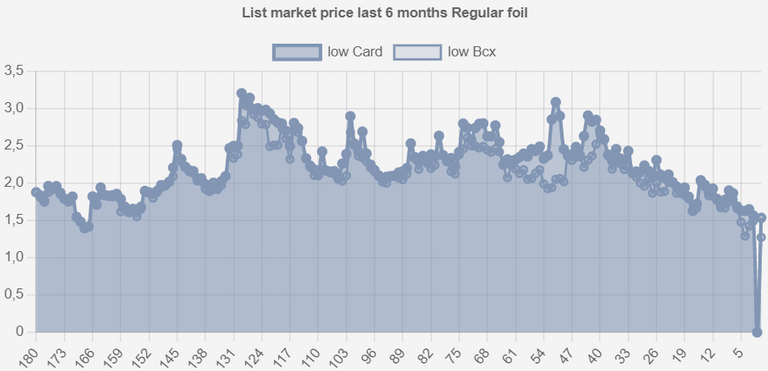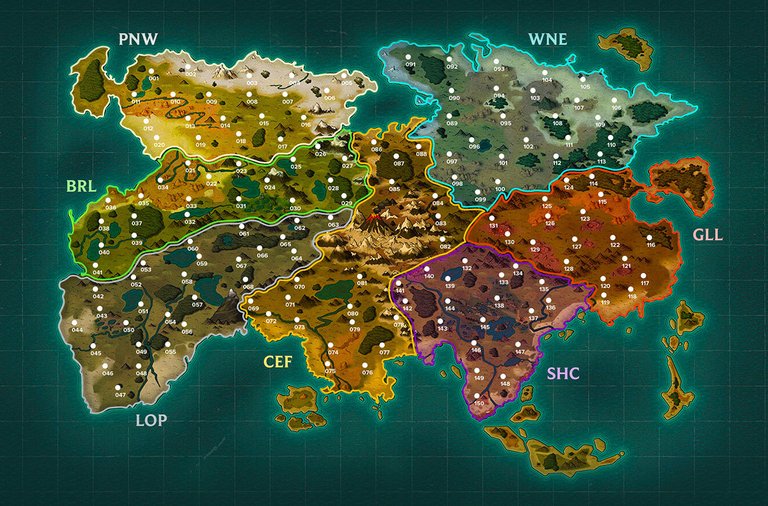
Click here to English Version.


Hoje eu não quero falar sobre batalhas dentro do Splinterlands, mas sobre batalhas que nós jogadores (e investidores) vivemos ao decidir alocar nosso capital em momentos de mercado como o que estamos passando. Um mercado urso é complicado e difícil de se enfrentar, portanto o nosso foco deve ser em sobreviver.

Antes de falarmos sobre como sobreviver neste mercado de baixa, primeiro precisamos entender em que contexto nos estamos inseridos e quais consequências isso nos trás, então vamos lá. Se você investiu seu dinheiro no Splinterlands (seja comprando cartas, DEC ou SPS), saiba que você está investindo em um mercado de altíssima volatilidade. Imagine as seguintes classificações.
 Renda fixa = seguro.
Renda fixa = seguro.
 Renda variável = arriscado.
Renda variável = arriscado.
Dentro da renda variável nós podemos dividir os tipos de investimentos de acordo com o seu grau de risco/volatilidade.
 Fundos imobiliários = baixo risco.
Fundos imobiliários = baixo risco.
 Ações = médio risco.
Ações = médio risco.
 Criptomoedas = alto risco.
Criptomoedas = alto risco.
Mas classificar criptomoedas com alto risco não significa que todas elas possuem o mesmo grau de risco, e é ai que muitos investidores erram ao fazer sua análise para decidir sobre investir ou não em alguma criptomoeda. Dentro dessa categoria de alto riscos há investimentos de menor volatilidade e outros mais voláteis, por exemplo:
 Criptos com maior marketcap como Bitcoin e Ethereum que possuem muito tempo de mercado são um pouco menos voláteis. Isso acontece por já estarem mais consolidadas e possuírem um grande público.
Criptos com maior marketcap como Bitcoin e Ethereum que possuem muito tempo de mercado são um pouco menos voláteis. Isso acontece por já estarem mais consolidadas e possuírem um grande público.
 Outras ramificações desse ecossistema são mais novos, como os NFTs e os Gamefi (é aqui onde o Splinterlands está) e por causa disso eles são mais voláteis (também podemos chamar de mais assimétricos). Eles possuem grandes chances de aumentar seu valor absurdamente mas também podem afundar até o abismo em um piscar de olhos. Isso é o que chamamos de investimento de altíssimo risco.
Outras ramificações desse ecossistema são mais novos, como os NFTs e os Gamefi (é aqui onde o Splinterlands está) e por causa disso eles são mais voláteis (também podemos chamar de mais assimétricos). Eles possuem grandes chances de aumentar seu valor absurdamente mas também podem afundar até o abismo em um piscar de olhos. Isso é o que chamamos de investimento de altíssimo risco.
Portanto, apesar de investir em criptomoedas já ser um alto risco, você pode aumentar o risco ainda mais ao investir em seguimentos mais novos como é o caso do Gamefi. Ao entendermos que o Splinterlands está dentro dessa categoria, fica fácil entender o porquê as cartas caíram tanto de preço no último ano.

Infelizmente os gráficos só mostram os últimos 6 meses e durante esse período não houveram grandes flutuações, entretanto se fosse possível puxar esse gráfico para o final de 2021, veríamos que o preço do Djinn Oshannus chegou a alcançar o valor de $ 50,00 por unidade! É uma enorme queda de preço no período de 1 ano, mas isso era previsto por se tratar de um setor de mercado de altíssimo risco.
Mas o que devemos fazer? Apenas vender tudo e desistir desse mercado traiçoeiro? Devemos sobreviver!
Durante o Bear Market você não precisa lucrar em todos os seus investimentos, tudo o que você precisa fazer é investir em coisas sólidas e que tendem a passar por esse Bear Market e viver o próximo ciclo de alta.
Para saber quais projetos sobreviverão é preciso analisar alguns aspectos extremamente importantes e se alguns deles forem atendidos então você estará um pouco mais seguro e aumentará suas chances de chegar ao fim deste Bear Market vivo (diferente de quem investiu em projetos pouco fundamentados e que morreram logo no início do Bear Market).
 Continuidade no desenvolvimento.
Continuidade no desenvolvimento.
Apesar dos baixos preços e da pouca entrada de capital, é extremamente importante que o projeto continue a ser desenvolvido durante o Bear Market, pois é nesse período em que o terreno é preparado para receber o próximo período de alta. O Splinterlands tem se mostrado positivo nesse aspecto pois está entregando muitas melhorias no jogo e apresentando suas primeiras versões das Lands, conteúdo que será essencial para o futuro do jogo e que poderá atingir patamares inimagináveis no futuro.

 Capital
Capital
Dinheiro é sempre importante e estar bem capitalizado é o que permite ao projeto continuar seu desenvolvimento sem depender de dinheiro entrando do mercado (no mercado de baixa o fluxo é inverso pois há mais dinheiro saindo). O Splinterlands apesar de estar bem capitalizado precisou rebalancear seus custos para garantir que eles conseguirão passar por esse inverno prolongado (esse Bear Market provavelmente será o mais longo que o mercado de cripto enfrentou). Para isso infelizmente a equipe foi reduzida e tudo foi explicado nesta postagem.
 Product Market Fit
Product Market Fit
Apenas oferecer a gema do milhão não significa que a criptomoeda estará agregando algo ao mercado e que exista uma demanda real para ela. Este é o ponto mais difícil de ser atingido e é o principal problema da maioria das criptomoedas. Ter seu produto adequado ao mercado e conseguir captar essa demanda garante tração e crescimento da sua base mesmo em momentos de baixa. Infelizmente ainda há muito a se desenvolver nesse quesito para que o Splinterlands alcance esse Product Market Fit (apesar dele já possuir, ainda está bastante restrito).
Eliminar as principais barreiras para o novo jogador e desenvolver mecanismos que façam o jogador continuar querendo jogar independente de ser lucrativo ou não são as duas principais coisas que devem ser feitas pela equipe do Splinterlands para estruturarmos adequadamente o Product Market Fit.



Estamos em um inverno intenso e lucrar não deve ser o nosso objetivo. Apenas sobreviver já será uma vitória e para isso precisamos investir em projetos que estejam mais sólidos e apresentem os critérios mencionados acima para aumentar sua confiança neles. Entender o grau de risco que você está assumindo também possibilita que você aloque adequadamente o seu capital, diversificando-o para aumentar ainda mais suas chances de sobrevivência.

Apesar de estar dentro de uma categoria de altíssimo risco o Splinterlands tem se mostrado muito sólido em meio ao Bear Market e o seu contínuo desenvolvimento me deixa muito seguro para continuar acumulando para o próximo mercado de alta. Até lá serão criadas inúmeras novas mecânicas e estruturas para facilitar a entrada do novo jogador e atrações para fazer com que ele permaneça jogando, como é o caso das Lands. Lembre-se que atrelado ao altíssimo risco está a altíssima assimetria, podendo oferecer ganhos astronômicos àqueles que aguentaram passar por momentos tão difíceis quanto os que estamos vivendo. É hora de sobreviver!
Muito obrigado a todos que leram até aqui, espero que tenham gostado. Se vocês curtirem meus conteúdos, peço que deixem o seu voto na postagem e sigam o meu perfil para poderem acompanhar as futuras postagens.





Today I don't want to talk about battles inside Splinterlands, but about battles that we players (and investors) live when deciding to allocate our capital in moments like the one we are going through. A bear market is complicated and difficult to face, so our focus should be on surviving.

Before we talk about how to survive in this bear market, we first need to understand the context we are in and what consequences this brings us, so let's go. If you've invested your money in Splinterlands (whether buying cards, DEC or SPS), know that you're investing in a very high volatility market. Imagine the following ratings.
 Fixed income = insurance.
Fixed income = insurance.
 Variable income = risky.
Variable income = risky.
Within variable income we can divide the types of investments according to their degree of risk/volatility.
 Real estate funds = low risk.
Real estate funds = low risk.
 Stocks = medium risk.
Stocks = medium risk.
 Cryptocurrencies = high risk.
Cryptocurrencies = high risk.
But classifying cryptocurrencies with high risk does not mean that they all have the same degree of risk, and this is where many investors make the mistake of doing their analysis to decide whether or not to invest in some cryptocurrency. Within this high-risk category, there are investments of lower volatility and others that are more volatile, for example:
 Cryptos with higher marketcap like Bitcoin and Ethereum that have been on the market for a long time are slightly less volatile. This happens because they are already more consolidated and have a large public.
Cryptos with higher marketcap like Bitcoin and Ethereum that have been on the market for a long time are slightly less volatile. This happens because they are already more consolidated and have a large public.
 Other branches of this ecosystem are newer, such as NFTs and Gamefi (this is where Splinterlands is) and because of that they are more volatile (we can also call of more asymmetric ones). They have great chances to increase their value absurdly but they can also sink to the abyss in the blink of an eye. This is what we call a very high risk investment.
Other branches of this ecosystem are newer, such as NFTs and Gamefi (this is where Splinterlands is) and because of that they are more volatile (we can also call of more asymmetric ones). They have great chances to increase their value absurdly but they can also sink to the abyss in the blink of an eye. This is what we call a very high risk investment.
So, although investing in cryptocurrencies is already a high risk, you can increase the risk even more by investing in newer segments like Gamefi. When we understand that Splinterlands is within this category, it is easy to understand why the cards have dropped so much in price in the last year.

Unfortunately the charts only show the last 6 months and during this period there were no big fluctuations, however if it were possible to pull this chart to the end of 2021, we would see that the price of Djinn Oshannus reached $ 50 per unit! It's a huge price drop in the period of 1 year, but this was predicted because it is a very high risk market sector.
But what should we do? Just sell everything and give up this treacherous market? We must survive!
During the Bear Market you don't need to profit on all your investments, all you need to do is invest in solid things that tend to go through this Bear Market and live the next bull cycle.
To know which projects will survive, it is necessary to analyze some extremely important aspects and if some of them are met then you will be a little safer and will increase your chances of reaching the end of this Bear Market alive (unlike those who invested in projects with little foundation and who died right at the beginning of the Bear Market).
 Continued development.
Continued development.
Despite the low prices and low capital inflows, it is extremely important that the project continues to be developed during the Bear Market, as it is during this period that the ground is prepared to receive the next boom period. Splinterlands has been positive in this regard as it is delivering many improvements to the game and presenting its first versions of Lands, content that will be essential for the future of the game and that could reach unimaginable levels in the future.

 Capital
Capital
Money is always important and being well capitalized is what allows the project to continue its development without depending on money coming in from the market (in the bear market the flow is reversed as there is more money coming out). Splinterlands despite being well capitalized needed to rebalance their costs to ensure they make it through this extended winter (this Bear Market will likely be the longest the crypto market has faced). For this unfortunately the team was reduced and everything was explained in this post.
 Product Market Fit
Product Market Fit
Just offering the gem of the million does not mean that the cryptocurrency will be adding something to the market and that there is a real demand for it. This is the hardest point to hit and is the main problem with most cryptocurrencies. Having your product suited to the market and being able to capture this demand ensures traction and growth of your base even in times of downturn. Unfortunately, there is still a lot to develop in this regard for Splinterlands to reach this Product Market Fit (although it already has it, it is still quite restricted).
Eliminating the main barriers for the new player and developing mechanisms that make the player continue to want to play regardless of whether it is profitable or not are the two main things that must be done by the Splinterlands team to properly structure Product Market Fit.



We are in an intense winter and making a profit should not be our goal. Just surviving will be a victory and for that we need to invest in projects that are more solid and present the criteria mentioned above to increase your confidence in them. Understanding the degree of risk you are taking also allows you to appropriately allocate your capital, diversifying it to further increase your chances of survival.

Despite being within a very high risk category, Splinterlands has proven to be very solid in the midst of the Bear Market and its continued development makes me very confident to continue accumulating for the next bull market. Until then, countless new mechanics and structures will be created to facilitate the entry of the new player and attractions to keep him playing, as is the case with Lands. Remember that linked to the very high risk is the very high asymmetry, which can offer astronomical gains to those who have endured going through times as difficult as the ones we are going through. It's time to survive!
Thank you so much to everyone who read this far, I hope you enjoyed it. If you like my content, I ask you to send your vote on the post and follow my profile so you can read future posts.







